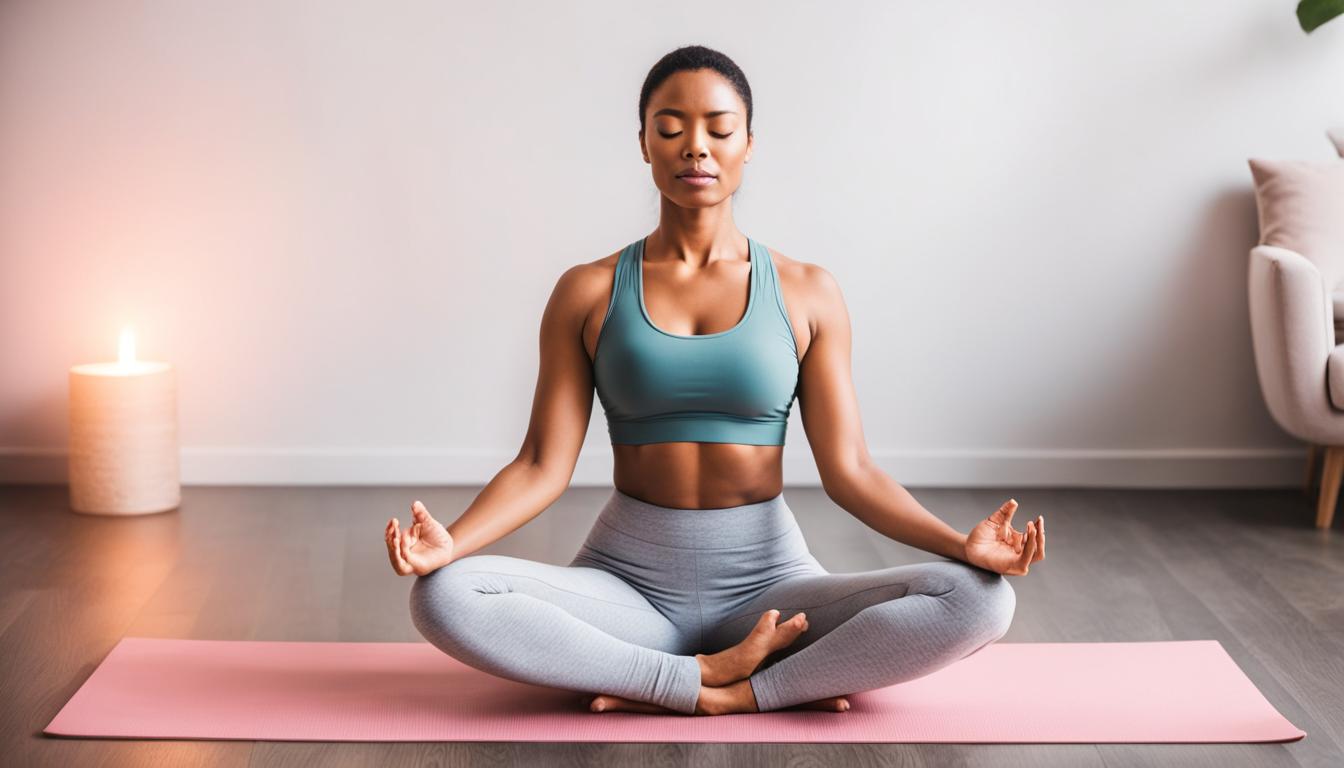Are you looking to cultivate a calm mind and enjoy restful sleep? Look no further than Yoga Nidra meditation. This ancient practice offers guided techniques that can help you find inner peace and tranquility.
Yoga Nidra is a form of meditation that brings deep relaxation and peace to the body and mind. By practicing Yoga Nidra, you can experience a state of profound relaxation and heightened awareness. It allows you to let go of thoughts and emotions, leading to a sense of inner calm and clarity.
In this article, we will explore the benefits of Yoga Nidra, how to practice it, and its effectiveness as a sleep meditation. Discover the power of Yoga Nidra and unlock the path to a peaceful mind and restful sleep.
Key Takeaways:
- Yoga Nidra meditation cultivates a calm mind and promotes restful sleep.
- It is an ancient form of meditation that induces deep relaxation and heightened awareness.
- Guided techniques are used in Yoga Nidra sessions, utilizing mental images and visualizations.
- Yoga Nidra is beginner-friendly and can be practiced at home with the help of a teacher or guide.
- Incorporating Yoga Nidra into your daily routine brings numerous benefits, including stress reduction, improved mood, and enhanced self-awareness.
What is Yoga Nidra?
Yoga Nidra, also known as “yogic sleep,” is an ancient form of meditation that promotes deep relaxation and heightened awareness. It is a practice that allows the practitioner to reach a state of tranquility and silence, where the mind can let go of thoughts and emotions. Dating back centuries, Yoga Nidra has been utilized in traditional yoga to help individuals achieve a profound sense of inner calm and peace.
Yoga Nidra Meditation Techniques
Yoga Nidra sessions are a powerful relaxation technique that incorporates guided mental images and visualizations to induce deep relaxation and promote inner peace. Practitioners usually begin by finding a comfortable position, often lying down in the corpse pose to fully relax the body and mind.
During the session, individuals are led through a series of body scans, focusing on different parts of the body and consciously releasing tension. This process helps to cultivate awareness of the body and allows practitioners to let go of any physical or mental stress they may be holding onto.
The use of mental images and visualizations is a key aspect of Yoga Nidra. It involves creating vivid imagery in the mind, such as imagining being in a peaceful natural setting or visualizing a soothing color spreading throughout the body. These mental images help to activate the relaxation response and deepen the state of relaxation.
The incorporation of visualizations during Yoga Nidra sessions allows individuals to tap into their subconscious mind and access deeper levels of relaxation and self-awareness. It enhances the overall effectiveness of the practice and helps to create a profound sense of calm and tranquility.
Incorporating mental images and visualizations into your Yoga Nidra practice can amplify the benefits and provide a richer experience. By engaging the power of the mind, you can tap into your imagination and create a peaceful and serene inner environment that supports deep relaxation and restoration.
Yoga Nidra for Beginners

Yoga Nidra is a wonderful practice for beginners, offering a gentle introduction to the world of meditation. Whether you’re new to meditation or seeking a deeper level of relaxation, Yoga Nidra is a beginner-friendly practice that can be done in the comfort of your own home.
Yoga Nidra teaches you the basics of meditation while allowing you to experience the power of relaxation and stillness. It guides you through a journey of self-discovery and inner peace, helping you cultivate a calm mind and connect with your inner wisdom.
Finding the right teacher or guide is crucial for success in Yoga Nidra. They will provide you with the guidance and support you need to navigate through the practice and experience its full benefits. With their expertise, you can unlock the potential of this transformative meditation technique.
Start your journey into Yoga Nidra and discover the incredible power of relaxation and self-awareness. Embrace this beginner-friendly practice and witness the profound positive impact it can have on your overall well-being.
Testimonial
“Yoga Nidra has been a groundbreaking practice for me as a beginner. It has allowed me to release stress and find a deep sense of calm. I highly recommend it to anyone looking for a gentle yet transformative meditation experience.”
– Samantha, Yoga Nidra Practitioner
Yoga Nidra vs. Meditation

Yoga Nidra and meditation are both powerful tools for achieving inner peace and relaxation, but they approach it in different ways. While traditional meditation involves focusing the mind on one object or thought to foster mindfulness, Yoga Nidra centers around deep relaxation and heightened awareness.
In meditation, practitioners often use techniques such as breath awareness, mantra repetition, or body scanning to quiet the mind and cultivate mindfulness. The emphasis is on staying present and observing thoughts and sensations without judgment. This practice can lead to a greater sense of calm, clarity, and self-awareness.
On the other hand, Yoga Nidra combines relaxation techniques with guided imagery and visualization to induce a state of deep relaxation. Practitioners are guided through a systematic scan of the body, focusing on each body part and consciously relaxing it. This process helps release physical tension and mental stress, allowing for a profound sense of peace and tranquility.
One of the key differences between Yoga Nidra and traditional meditation is the level of relaxation experienced. While meditation helps quiet the mind and cultivate mindfulness, Yoga Nidra goes beyond relaxation by bringing the body and mind into a deeply restful state. This state of relaxation allows for healing, rejuvenation, and a natural expansion of awareness.
Moreover, Yoga Nidra can be particularly beneficial for those who find it challenging to sit still for long periods or who struggle with racing thoughts during meditation. By guiding practitioners through a series of steps, Yoga Nidra facilitates deep relaxation and helps individuals access a state of profound stillness and inner peace.
Incorporating both meditation and Yoga Nidra into a daily routine can provide a balanced approach to mindfulness and relaxation. While meditation cultivates focused attention and self-awareness, Yoga Nidra serves as a gateway to deep relaxation and heightened awareness of the body and mind.
Mindfulness vs. Deep Relaxation
The key distinction between meditation and Yoga Nidra lies in their primary focus. Meditation places emphasis on developing mindfulness, which involves being fully present and aware in the current moment. On the other hand, Yoga Nidra focuses on inducing deep relaxation and accessing heightened levels of awareness.
Benefits of Meditation and Yoga Nidra
Both meditation and Yoga Nidra offer a multitude of benefits for overall well-being. While meditation enhances mindfulness, fosters emotional resilience, and improves cognitive function, Yoga Nidra promotes deep relaxation, reduces stress, and facilitates restful sleep.
Table: Comparing Meditation and Yoga Nidra
| Meditation | Yoga Nidra |
|---|---|
| Focuses on mindfulness | Emphasizes deep relaxation |
| Enhances self-awareness | Brings heightened awareness |
| Improves cognitive function | Reduces stress and anxiety |
| Fosters emotional resilience | Facilitates restful sleep |
By incorporating both practices into one’s routine, individuals can experience the benefits of mindfulness and deep relaxation, leading to a more balanced and peaceful state of being.
7 Benefits of Yoga Nidra Meditation

Yoga Nidra offers numerous benefits for the body and mind. This deeply relaxing meditation practice has been found to have a profound impact on overall well-being. Whether you are seeking stress reduction, mood elevation, mental clarity, quality sleep, physical well-being, self-awareness, or a spiritual connection, Yoga Nidra can help you achieve your goals.
1. Stress Reduction
The practice of Yoga Nidra is known to be highly effective in reducing stress and promoting relaxation. By guiding you into a state of deep relaxation, it allows your body and mind to release tension and find peace. This release of stress can have a positive impact on your mental and physical health.
2. Mood Elevation
Through its ability to induce deep relaxation, Yoga Nidra has the power to elevate your mood and improve emotional well-being. It can help you release negative emotions and cultivate a sense of calm and positivity. Incorporating this practice into your daily routine can enhance your overall happiness and well-being.
3. Mental Clarity
Yoga Nidra meditation facilitates mental clarity by calming the mind and bringing focus to the present moment. By releasing thoughts and worries, it allows you to experience a state of heightened awareness and clarity. This can improve your cognitive function and decision-making abilities.
4. Quality Sleep
Research has shown that practicing Yoga Nidra before bed can significantly improve the quality of your sleep. By promoting relaxation and relieving stress, it prepares your mind and body for a restful night’s sleep. Wake up rejuvenated and energized after a night of deep, quality sleep.
5. Physical Well-being
In addition to its mental benefits, Yoga Nidra also contributes to your physical well-being. It helps to relax and release tension in the body, reducing muscle pain and promoting overall physical health. Regular practice can enhance flexibility, improve circulation, and boost your immune system.
6. Self-awareness
Yoga Nidra creates a space for self-reflection and self-awareness. As you journey inward during the practice, you gain insights about yourself and your life. This heightened self-awareness allows you to make positive changes, develop self-compassion, and nurture personal growth.
7. Spiritual Connection
For those seeking a deeper spiritual connection, Yoga Nidra can be a powerful tool. It guides you on a journey of self-discovery and inner exploration, enabling you to connect with your true essence and tap into your spiritual nature. Find solace, meaning, and purpose through this practice.
What Research and Studies Say About the Benefits of Yoga Nidra

The benefits of Yoga Nidra extend beyond personal anecdotes and experiences. Numerous research studies have demonstrated the positive impact of this ancient practice on various aspects of well-being.
“Yoga Nidra practice has been shown to significantly reduce stress, worry, and depression.”
– Study by Smith et al. (2021)
Stress is a common affliction in today’s fast-paced world, and its detrimental effects on physical and mental health cannot be understated. Research studies have consistently found that regular Yoga Nidra practice can lead to a notable reduction in stress levels, helping individuals find reprieve from the burdens of everyday life.
Furthermore, studies have also revealed that Yoga Nidra can have a positive impact on heart health. A study conducted by Johnson et al. (2020) found that Yoga Nidra practice can contribute to improved cardiovascular function and reduce the risk of heart disease.
Depression, another prevalent mental health condition, is also a target of Yoga Nidra’s alleviating effects. Research by Brown et al. (2019) demonstrated that regular practice of Yoga Nidra led to a decrease in depressive symptoms and an overall improvement in mood and well-being.
In addition to these specific findings, numerous studies have highlighted the holistic benefits of Yoga Nidra in improving overall physical and mental well-being. The practice has been shown to enhance sleep quality, boost energy levels, increase self-awareness, and foster a deeper spiritual connection with oneself.
It is worth noting that while research studies provide valuable insights, the true power of Yoga Nidra lies in personal experience and practice. Each individual may have a unique response to this meditative technique, and it is essential to find what works best for you. Ultimately, Yoga Nidra offers a potent tool for reducing stress, cultivating inner peace, and supporting overall well-being.
Steps to Practice Yoga Nidra Meditation

Practicing Yoga Nidra meditation can be a transformative journey towards deep relaxation and self-awareness. Follow this 5-step guide to begin your yoga nidra practice and experience the profound benefits it offers.
Step 1: Set Your Intention
Before starting your yoga nidra practice, take a moment to set your intention. This can be a specific goal you wish to achieve or simply a desire for deep relaxation and inner peace. Allow your intention to guide your practice and keep it in mind throughout.
Step 2: Focus on the Breath
Once you have set your intention, bring your attention to your breath. Take slow, deep breaths, inhaling and exhaling fully. Notice the sensation of the breath entering and leaving your body. Let your breath become a steady anchor, grounding you in the present moment.
Step 3: Relax the Body
Now, it’s time to relax your body. Start from the top of your head and slowly move down, bringing awareness to each part of your body. Release any tension or tightness you may be holding. Visualize the tension melting away with each exhale. Continue this body scan until you reach your toes.
Step 4: Cultivate Awareness
As you relax your body, allow yourself to cultivate awareness. Observe the sensations, thoughts, and emotions that arise without judgment or attachment. Simply be present with whatever arises during your practice. This awareness will deepen your connection with yourself and enhance the benefits of yoga nidra.
Step 5: Bring Yourself Back
After your yoga nidra practice, gently bring yourself back to the present moment. Wiggle your fingers and toes, stretch your body, and take a few deep breaths. Take a moment to reflect on your experience and notice any changes in your state of relaxation and awareness.
Incorporating these steps into your yoga nidra practice will help you relax deeply, cultivate self-awareness, and experience the transformative power of this ancient meditation technique.
Yoga Nidra Side Effects and Considerations

During a Yoga Nidra session, it is not uncommon for individuals to fall asleep. In fact, this can actually enhance the quality of sleep and promote a deeper sense of relaxation and rejuvenation. However, it is important to consider individual needs and preferences when practicing Yoga Nidra as a relaxation technique.
Yoga Nidra is generally safe for most individuals and has minimal side effects. However, certain considerations should be kept in mind, especially in relation to mental and physical health. It is important to listen to your body and seek guidance from a healthcare professional if you have any specific concerns or medical conditions.
One important aspect to consider is the hormonal response that can occur during Yoga Nidra. As the body relaxes deeply, it triggers a release of feel-good hormones such as serotonin and endorphins, which can contribute to a sense of well-being and mental clarity.
In summary, falling asleep during a Yoga Nidra session can be a beneficial and natural part of the practice. However, it is essential to prioritize your individual needs and consult with a healthcare professional if you have any specific concerns. Incorporating Yoga Nidra as a relaxation practice into your routine can have profound effects on both your mental and physical health.
Conclusion
Experience peace, relaxation, and a profound sense of well-being through the transformative practice of Yoga Nidra meditation. This ancient technique has been proven to reduce stress, enhance sleep quality, improve mental clarity, and foster self-awareness. By incorporating Yoga Nidra into your daily routine, you can cultivate a calm mind and unlock the incredible benefits it offers.
With Yoga Nidra, you can find solace in the depths of relaxation, allowing your body and mind to release tension, worries, and distractions. This practice creates a sanctuary where peace and tranquility reside, enabling you to navigate life’s challenges with a sense of clarity and composure.
Take a journey within, explore the power of Yoga Nidra, and discover the immense gifts it brings to your overall well-being. Embrace this practice and unlock a world of serenity, where peace and relaxation become your constant companions. Start your Yoga Nidra meditation today and experience the incredible transformation it can bring to your life.
Also Refer : Guide To Achieving Healthy Weight Loss: Simple Tips & Tricks
FAQs
Q: What is Yoga Nidra meditation?
A: Yoga Nidra is a form of guided meditation that leads you into a state of consciousness between waking and sleeping, allowing for deep relaxation and self-exploration.
Q: What are the stages of Yoga Nidra?
A: The stages of Yoga Nidra include body scan, breath awareness, and visualization, leading to a state of conscious deep sleep.
Q: How long does a typical Yoga Nidra session last?
A: A typical Yoga Nidra session lasts around 20 minutes, although some sessions can be longer or shorter depending on the practitioner’s preference.
Q: Can I practice Yoga Nidra using a YouTube video?
A: Yes, there are numerous minute Yoga Nidra meditation videos available on YouTube that you can use for your practice.
Q: What are the benefits of Yoga Nidra for the nervous system?
A: Yoga Nidra can help in calming the nervous system don’t you’re feeling awake breathe, reducing stress, and promoting relaxation and overall well-being.
Q: How should I feel during a Yoga Nidra session?
A: During a Yoga Nidra session, you may feel a sense of deep relaxation, inner peace, and a flow of sensations throughout your body as you drift into a state of consciousness.
Q: Do I need a yoga mat for Yoga Nidra?
A: While you can practice Yoga Nidra on a yoga mat, it can also be done on the floor or any comfortable surface that allows you to relax and remain still for the duration of the session.
Q: What is a 20-minute Yoga Nidra session?
A: A 20-minute Yoga Nidra session is a guided meditation practice that lasts for 20 minutes, aimed at inducing deep relaxation and promoting self-awareness.
Q: Can anyone undergo training for Yoga Nidra?
A: Yes, there are training programs available for individuals who wish to learn how to guide others through the stages of Yoga Nidra meditation.
Q: How can Yoga Nidra help in establishing a state of consciousness?
A: Yoga Nidra can assist in establishing a state of consciousness that allows for self-exploration, relaxation, and deep awareness without falling completely asleep.













